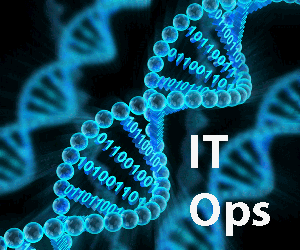CIOs face pressure from their business users to embrace more digitalization – specifically to increase engagement with customers using innovative IT services, extract greater value from information resources, and enable a new, mobile workforce.
As an example, I want you to imagine you’re the CIO of a major airline. In the morning, you have a meeting with other business executives. They are demanding faster delivery of the new mobile app that you promised them, which allows purchase of upgrades while people are sitting in economy at the gate.
They just found out that a competitor airline already has this feature and is generating additional revenue with it, and stealing your best elite customers at the same time.
So you go back to your developers and ask them for the status on the new app. They politely blame operations for the delay. So you pay a visit to your VP of Infrastructure and Operations, who explains to you that:
- Operations is organised to ensure stability and reliability, not rapid response
- Operations talent is difficult to find, train and retain meaning staff positions are unfilled
- Operations is overwhelmed with tasks, and doesn’t have a way of prioritising them with business priorities
It’s probably a bad time to tell your VP that you’re going to need to cut his budget to hire more developers. And the security team is complaining because operations isn’t keeping up with patches on the Windows servers, which is leaving the airline vulnerable to a data breach.
Surviving in an age of digitalization
Businesses must innovate in order to respond to competitive pressures and changing market needs, as a matter of survival. IT services lower the barrier of entry for competitors and are a critical part of competing in today’s marketplace. While the creation of new customer-facing IT services has been a part of the business landscape for decades, there is a new urgency to do so. Entire industries are being disrupted using differentiated IT services – witness what Uber or Amazon have done to the taxi and retail business.
This drive to innovate faster places significant pressure on existing IT operations practices to become more agile. Already straining to keep existing IT services running with insufficient skilled staff and constantly changing technology, operations organisations must now adapt to even greater rates of change coming from development teams. This sets up conflicting goals.
- CIOs must meet organisational expectations for innovation while simultaneously maintaining core business logic and applications, many of which have existed for a long period of time.
- Digitalization (digital transformation) places more information online, increasing the risk that business-critical IT services will impact customers directly, causing discontent or churn.
- In typical IT organisations, infrastructure & operations (I&O) consumes the lion’s share of the budget, making I&O the focus of most cost-optimisation efforts. Yet, I&O is critical to reliably delivering existing services that customers depend on. Cut the wrong wire and business damage can result.
The great challenge in IT operations is freeing up resources used inefficiently to reallocate them towards innovation, while embracing agility to move faster, without increasing risk. To thrive under the pressure to innovate and digitalize means gaining an understanding of business priorities, making better use of existing technologies and aligning operations better with development and security teams.
The impact of digitalization on IT operations
The irony is that digitalization results in greater complexity, a proliferation of devices, and additional points of risk such as unstructured data and shadow IT, all of which can reduce the agility needed to deliver on innovation. Is IT operations unsustainable in its current form, given the pressures of digitalization?
IT Operations, in particular, is challenged by the pressure to change brought on by digitalization. Operations teams value stability and are accustomed to a cautious approach to change, rather than rapid response to business priorities. Symptoms of unsustainability include:
- One-size-fits-all, complex architectures and processes that tend to be more fragile than agile.
- A tendency to rip and replace rather than consider capabilities that already exist.
- A focus on IT metrics related to speed, rather than IT metrics related to business priorities
- An uncertain path to adoption of disruptive technologies such as cloud services and mobile apps.
- An uneasy or even confrontational relationships with development and security teams.
- A hostile relationship with business managers and their tendency to adopt shadow IT.
While digital services are the competitive differentiator in today’s app-driven economy, CIOs also want and need to optimise IT operations, which often consumes 70% or more of most budgets (what Gartner calls the “run”), so they can reallocate resources towards the innovative creation of IT and business services. Yet, this must be carefully considered to avoid reducing the reliability of services.
Cost optimisation must also be performed without increasing the risk of data breaches or compliance violations. The burden of implementing and maintaining policy controls (such as revoking access as part of an access certification campaign) and patching systems (to eliminate vulnerabilities) falls on IT operations - not the security or compliance teams. Security can become an afterthought when the pressure to move faster increases.
The changing operations perspective
The operations perspective is now changing, driven by a deeper understanding that:
- Lack of standardisation around infrastructure, operating systems, management tools and so on contribute to high architectural complexity that makes operations more fragile than agile. Yet, with acquisitions and the pace of technology adoption increasing, standardisation is impossible to achieve.
- New methods must be adopted to deal with this inevitable complexity, such as rapid, automated recovery to resolve incidents rather than complex troubleshooting techniques, greater cross-platform support, extracting more value from existing investments and hiding the complexity from end users.
- Cloud services can be part of an innovation plan rather than an existential threat to operations.
- Users don’t care where the data resides – it’s about convenient, self-service access from anywhere, anytime and from any device.
- DevOps is not an attempt to seize operations by developers, but rather an opportunity to work together to become more agile, to effect better outcomes for the business, and improve efficiency.
These approaches can no longer address the demands of the digital economy. A lack of an agile approach leads to manual efforts that cannot scale, creating a bottleneck for the deployment of new services.
The Micro Focus Perspective
The Micro Focus perspective on IT operations has been evolving with our recent acquisitions to address these concerns. Our stated objective is to help our customers innovate faster with lower risk.
From an IT operations perspective, that means helping our customers to become more agile and responsive to business needs, optimise operational costs and accomplish that without introducing risks related to poor performance or security vulnerabilities.
We do this through three approaches:
- Enable partnerships with development and security. Operations and security teams tend to focus on minimising risk, while development organisations want to drive change. The trend towards DevOps and agile development must balance speed and risk, employing operations teams’ expertise in measuring outcomes and continuous improvement. Micro Focus provides capabilities to make innovation and digitalization a team effort through automation of processes that gets software into production faster while mitigating the risks of service outages, breaches or compliance violations.
- Drive successful use of emerging – and existing technologies. From virtualization to cloud and mobile apps, emerging technologies offer advantages to the organisations that can capitalise on them best, not necessarily first. Micro Focus provides IT Operations capabilities to manage emerging technologies so that they work as expected, increasing user productivity and customer engagement. And Micro Focus helps bridge the old with the new by providing ways to connect legacy and emerging operations technologies, to gain more from investments already made.
- Shift focus from technology to business outcomes. Successful operations of IT services should not be measured solely using IT metrics. In order for IT operations to play its role in boosting user productivity and support greater innovation, resources must be prioritised based on business impact. Lack of business user productivity and frustration will lead to shadow IT. Micro Focus helps operations teams prioritise efforts and offer productivity enhancements to the business by measuring results based on business outcomes, allowing opportunities to shift resources towards innovation that drives business growth.
What makes our approaches unique is that we have a number of technologies that allow the modernisation of proven software. There is risk in ripping and replacing legacy software that has proven its reliability over years or decades of use. Modernisation allows those applications to support, integrate with, or run on the latest technologies, providing a lower-cost and lower-risk approach to innovation.
The Micro Focus solutions
The breadth of Micro Focus solutions, coupled with our deep expertise in operational processes and technologies enable our customers to innovate, keep their services performing, find ways to optimise costs and adopt emerging operations technologies.
In order to enable partnerships, Micro Focus:
- Supports prioritisation by the business perspective through IT Service Management
- Helps the business share innovation ideas through Collaboration
In order to adopt emerging technologies, Micro Focus:
- Enables the migration of files systems for the most efficient use of infrastructure – physical, virtual or cloud – automatically through Data center transformation
- Aids in maintaining peak application performance through Application Performance Management
- Supports e-discovery and legal hold requirements across a range of communications - social, mobile, texting and email through Enterprise information archiving (also known as content archiving)
In order to optimise costs with existing technologies, Micro Focus:
- Reduces the costs of maintaining tablets, smartphones, PCs and Macs in a consistent way so the workforce and IT stay productive through Unified Endpoint Management
- Reduces unnecessary overhead and frees IT from menial tasks while hiding the complexity from the end user through User self-service
- Offers solutions to maintain continuity of service cost-effectively and deliver rapid resiliency that can reduce the need for troubleshooting through automated Disaster recovery
In order to increase agility, Micro Focus:
- Enables an integrated DevOps approach and innovative digitalization of process through Business and IT process orchestration
- Provides the right contextual amount of authentication to make user access convenient regardless of how or where information is accessed through Identity and Access Management
Together, these Micro Focus technologies enable operations teams to:
- Align IT objectives to business objectives without sacrificing service performance
- Find ways to gain more efficiency from existing operational investments while adopting emerging technologies, such as cloud services, where they support business objectives
- Balance the pressure to innovate faster with the pressure to optimize operations costs
- Embrace operational agility through DevOps practices, while bringing the best of operations experience to deliver quality of service to the business and users
- Enable users to collaborate freely yet securely and supportive of regulations
Ultimately, Micro Focus believes that in order to be sustainable, IT operations must adopt an agile approach that takes full advantage of existing investments, in order to support increasing digitalization without disrupting existing business. We stand ready to help you on your journey towards agile operations.
This article was first published in OH Magazine Issue 36, 2017/1, p12-15




